 THE
SCORPION KING
THE
SCORPION KING
|
Scorpion, also King Scorpion or Scorpion II refers to the second of two kings so-named of Upper Egypt during the Protodynastic period. The only pictorial evidence of his existence is the so-called Scorpion Macehead that was found in the by two archeologists in a temple at Nekhen (Hierakonpolis) during the dig season of 1897/1898. It is currently on display at the Ashmolean Museum, Oxford. The stratigraphy of this macehead was lost due to the methods of its excavators, but its style seems to date it to the very end of the Predynastic Period. Though badly damaged, the visible parts are extraordinary records from this early time in Egyptian history. He is believed to have lived just before or during the rule of Namer at Thinis for this reason, and also because of the content of the macehead. The macehead depicts a single large figure wearing the white crown of Upper Egypt. He holds a hoe, which has been interpreted as a ritual either involving the pharaoh ceremonially cutting the first furrow in the fields, or opening the dikes to flood them. The name "Scorpion" is derived from the image of a scorpion that appears immediately in front of his face, just below a flower with seven petals; the use and placement of the iconography is similar to the depiction of the pharaoh Narmer on the obverse side of the Narmer palette. Protodynastic hieroglyphics are difficult to read, but the dead lapwings (meaning Lower Egyptians) and the nine bows (meaning the traditional enemies of Egyptians) found on the macehead are interpreted as evidence that he began the attacks on Lower Egypt which eventually resulted in Narmer's victory and unification of the country. The lapwing was also used as a hieroglyph meaning "common people", so the standards they are attached to may represent the names of particular towns Scorpion conquered. A second, smaller mace head fragment is referred to as the Minor Scorpion mace head. Little is left of this mace head, though it clearly depicts the pharaoh wearing the Red Crown of Lower Egypt. There are several theories regarding his identity. Some would argue that because Egyptian kings of the First Dynasty seem to have had multiple names, that Scorpion was the same person as Narmer, simply with an alternate name. Others have argued that the name of Narmer's predecessor, Ka, is simply a stylistically different version of a scorpion, and that both kings are the same person, who would have been named Sekhen. The historian Susan Wise Bauer maintains that Scorpion II and Narmer were indeed two separate kings, but that Scorpion II reigned in 3200 BC, a century before Narmer. Because Scorpion II is not attested at Abydos, he could be a contemporary king to Narmer who eventually lost or bequeathed Nekhen to Narmer.
|
![]() Copyright(C) 2007
- 2020. All rights reserved.
Copyright(C) 2007
- 2020. All rights reserved.

THE MUMMY: TOMB OF THE EMPEROR